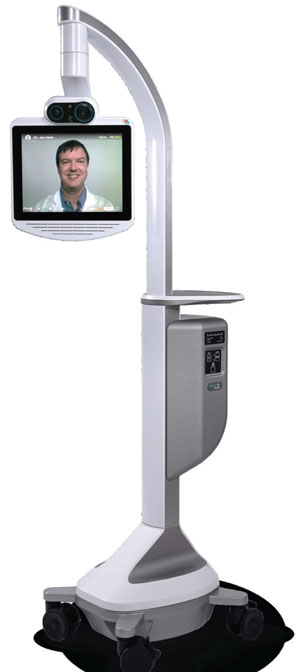Establishing a neonatal telemedicine service in Liverpool
Consultant Neonatologist, Liverpool Women’s Hospital
fauzia.paize@lwh.nhs.uk
Simon Minford
Advanced Paediatric Nurse Practitioner and Clinical Innovation Consultant, Alder Hey Children’s Hospital
Joanne Minford
Consultant Paediatric and Neonatal Surgeon, Alder Hey Children’s Hospital
Christopher Dewhurst
Consultant Neonatologist, Liverpool Women’s Hospital
Liverpool’s neonatal care is divided between the neonatal intensive care unit at Liverpool Women’s Hospital (LWH) and Alder Hey Children’s Hospital (AHCH). Around 8,500 babies are born at LWH each year and the tertiary neonatal intensive care unit (NICU) is on this site. If babies require specialist intervention such as neonatal surgery, extracorporeal membrane oxygenation (ECMO) or cardiac specialist input the babies are transferred to AHCH.
The hospitals are 3.5 miles apart. For several years LWH and AHCH have been working in partnership to ensure the babies of Liverpool receive the best care possible. Presently there are 44 cots on the LWH site and a further nine high dependency cots on the surgical high dependency unit at AHCH. The neonatal medical and nursing staff rotate between the two sites with surgical consultants also undertaking ward rounds on the LWH site for three days a week. In early 2023 a new NICU will open on the AHCH site comprising 22 cots for preterm surgical and cardiac babies. This neonatal care across the city is provided by a partnership arrangement; the Liverpool Neonatal Partnership.
Just in time
As part of the development of the new NICU at AHCH, members of the American Mayo Clinic team were invited to give a presentation on their neonatal telemedicine programme. This took place on 2 March 2020. The Mayo Clinic uses telemedicine to support peripheral hospitals in the resuscitation and support of babies born outside of tertiary centres. In the second week of March 2020 the UK was heavily involved with the impending coronavirus pandemic and it was quickly realised that the telemedicine service that had been presented just days before could be vital in supporting the Liverpool Neonatal Partnership in continuing to provide a safe and sustainable service across both LWH and AHCH.
Over the following two weeks, working with the Alder Hey Innovation Hub and the company InTouch Health (now Teladoc Health) that produced the telemedicine systems, telemedicine ‘robots’ were implemented on both sites. On Monday 23 March the UK went into lockdown because of the coronavirus pandemic. Due to sickness, self-isolation and shielding we initially lost 50% of the consultant workforce with seven out of 14 consultants having to remain at home. This resulted in a reduction of 40% in clinical facing time available for consultants; our service was unsustainable.
Fortunately, on 24 March 2020 the first telemedicine robots arrived; one at LWH and a second at AHCH. The shielding and isolating consultant workforce who were at home, were trained remotely on how to access the tele-medicine system. We developed a rota for the new ‘virtual consultant’, which included full ward round cover for the neonatal surgical unit on the AHCH site and the low dependency unit on the LWH site. This allowed those consultants at home to continue to provide a full clinical service. The clinicians who were able to give face-to-face consultations provided care on the high dependency and intensive care units. The virtual neonatologist also supported the postnatal ward with ad hoc reviews. To reduce footfall and allow them to remain on site at AHCH, the surgeons utilised the robot at the LWH site and were able to review babies remotely within a few minutes of being contacted.

TABLE 1 A telemedicine robot (photo: Teladoc Health Inc).
Working with robots
The telemedicine robots are easy to work with and they take just 15 minutes (approximately) of training per consultant to learn how to use them. They have very high-quality image visualisation. The virtual consultants can zoom in on babies easily from their workspace. The resolution of the camera on the robots is such that the surgeons can closely review a baby’s abdominal wounds or stomas, etc.
The families seemed very accepting of this new way of working and one consultant commented on how, even having never met families in person, he was able to develop a relationship with them.
Then, now and the future
We lost 66 hours of consultant time per week and we replaced that with one virtual consultant. To provide additional locum payments for the absent sessions over a three-month period would have cost approximately £100,000. The virtual consultant continued to provide this care within their existing job plan. Consultants who were confined to their homes were able to provide clinical care and remained a part of the team, contributing to the overall workload of the service. This benefited their mental health and wellbeing as they had been a vital part of a well-functioning on-site team prior to 23 March 2020.
The LDU ward round continues to be provided virtually by at-risk consultants. The AHCH ward round is a mixed virtual and physical ward round.
What does the future hold? We are undertaking a survey on parental experience about the telemedicine system. We are working with the Mayo Clinic to carry out an accompanying research programme comparing telemedicine as an outcome compared to traditional care. The use of the telemedicine system has expanded to cardiologists, plastic surgeons and other specialties. We are in discussion with the North West Operational Delivery Network to implement teleneonatology over a wider footprint; supporting local neonatal units in the provision of neonatal care. We are using the system to connect echo-cardiography equipment, allowing specialist review of our images.
The implementation of the Liverpool Neonatal Partnership teleneonatology programme was completed in just four weeks; things can move extremely quickly when you really need them to!
Or read this article in our
Tablet/iPad edition


